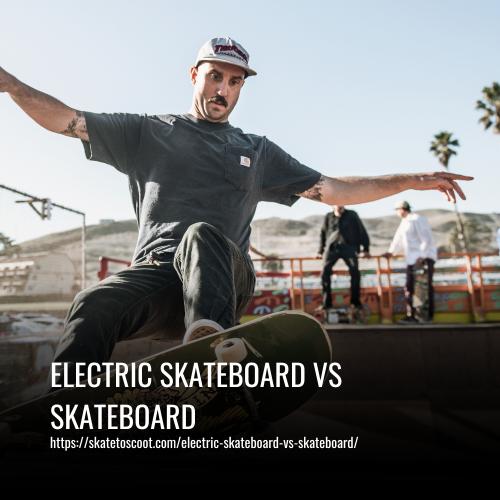As an Amazon Associate we earn from qualifying purchases.
Skateboarding is one of the most popular activities for thrill-seekers, but with so many different products on the market, it can be hard to decide which one to get. Electric skateboards are becoming increasingly popular due to their lightweight and speed capabilities, making them a great alternative to traditional skateboards.
Through our exploration of each product, I hope you will gain valuable insights into their pros and cons, as well as understand which type will give you the ultimate ride experience.
| Area of comparison | Electric skateboards | Normal skateboards |
| Wheels | Hub and belt-driven types | No electronic components, purely urethane |
| Deck Height | More stable with low height, but height doesn’t matter as much | Less tiring to push on lower height |
| Stability | More stabilized because of the skateboard’s weight | Stable with larger wheels and lower deck heights |
| Range and Speed | Top speed of 35 mph | 5-12 miles per hour |
| Weight | Heavier | Lighter |
| Durability | Electronic components prone to water damage | Fewer water damage concerns |
| Community restrictions | More restriction in the cities | Can be taken almost anywhere |

What Are The Differences Between An Electric Skateboard And A Regular Skateboard?
When it comes to skateboards, there are quite a few differences between the traditional and electric ones. It’s important to consider each before choosing which type you want.
1. Speed:
When it comes to skateboards, speed is the name of the game. For those who want an extra boost, electric skateboards provide a reliable way to increase your speed. An electric skateboard can reach speeds of up to 20 mph, a feat that can’t be accomplished with a regular skateboard.
However, with such high speeds comes great responsibility. The handling capability of an electric skateboard can be difficult for younger and inexperienced riders to handle properly. So if you’re looking for a faster way to cover long distances while still being able to control your speed, then an electric skateboard may be the right choice for you.
2. Commuting Experience:
When it comes to commuting, particularly over a short distance, skateboarding is a great option. And electric skateboards are even better since they can provide the same experience with much faster speeds. This means that the whole experience of commuting changes drastically depending on which type of board you use.
If speed and convenience are what you want from your commute, then an electric skateboard will be perfect for you. But if you prefer to take it slow and savor the beautiful surroundings around you during your commute, then no electric skateboard can beat the traditional one!
3. Safety:
Electrically powered and regular skateboards both have their possible safety risks to consider.
However, it is important to consider the individual perspectives of each rider when assessing the level of safety associated with riding either type of board.
Personally, I believe that electric skateboards present a greater risk due to the higher speed they can reach. If a rider were to lose control or run over an unexpected obstacle with an electric skateboard, it would be much easier for them to be thrown off compared to a regular board.
It’s true that modern electric skateboards are equipped with sophisticated braking mechanisms meant to increase safety. However, it remains true that riding on an electric skateboard is still more unsafe than riding on a regular one.
4. Size And Weight:
When it comes to electric and non-electric skateboards, size and weight are important factors to consider. Cruiser boards typically offer a greater variety of shapes because they don’t have any electrical components taking up space.
Examples of cruiser-style boards that can be used for short commutes include the Landyachtz Turbo King and Backfire Mini.
Normal skateboards are lighter and easier to bring around, while electric skateboards can weigh from 3KG+ up to 10KG+, sometimes even heavier than lightweight bicycles. Weighing an e-skateboard is essential for its intended use, so make sure you consider your usage before investing in one.
For city-commuting purposes, shorter longboards or cruiser boards work best due to their smaller size and maneuverability when navigating through crowded areas or tight corners. Longboards may offer greater stability and comfort on long journeys, but don’t benefit from having a kicktail allowing you to carry without having to bend down.
5. Wheels:
Wheels are an essential part of any e-skateboard and can make all the difference in how your board performs. There are two types of wheels for these boards: hub motor and belt-driven.
Hub motor wheels are quieter, more powerful, and require less maintenance than the belt-driven variety. The polyurethane on these wheels is also more durable, though you must check with the manufacturer first if it can be replaced. On the flip side, however, they cannot be replaced like you would with a regular skateboard wheel.
Belt-driven wheels do have their place; they offer less resistance when pushed without power so if you plan your trips well and remember to keep your battery full, then running out of power shouldn’t be a major problem.
However, they do require more maintenance as their belts can wear down over time and need to be replaced periodically.
Overall, hub motor designs seem to take the cake when it comes to wheels because they both look better visually (due to their cables) and perform better in terms of both power and upkeep.
6. Deck Height:
When it comes to non-electric skateboards, deck height is incredibly important. The lower the deck, the easier it will be to push your board. This is due to the fact that the lower the deck, the better stability and less effort are required in pushing it.
E-skateboards are typically designed to have high decks without compromising maneuverability since they don’t need to be pushed unless the battery runs out.
However, when choosing a non-electric skateboard, make sure to take into consideration how low of a deck height you need for optimal performance. Lower decks bring with them greater stability due to their reduced center of gravity.
7. Stability:
When it comes to skateboards, stability is key. Fortunately, there are several different factors you can consider when choosing a board that will be both sturdy and comfortable. These include wheelbase, deck height, weight, wheels, and road conditions.
The larger the wheelbase and the lower the deck height of your board, the more stability it will provide. Heavier boards like e-skateboards naturally offer more stability due to their battery packs – although they may not be as ideal for carrying around long distances.
For those who prefer something light and zippy for short-distance cruising, a cruiser board might be a better fit. The Landyachtz Rally Cat has a rocker (lower deck) which helps improve its stability while also pushing it forward easier despite its lightness.
8. Batteries And Range:
If you’re looking for a good range on your e-skateboard, you’ll want to look for higher-capacity batteries. Of course, the amount of range you need depends on your commuting distance: if you don’t need to go far, then smaller capacity batteries will suffice, since they are lighter in weight.
No matter what kind of battery you choose, it will wear down over time due to use. The capacity of Lithium batteries typically drops by around 80% within 300-500 full charge/discharge cycles — this equates to approximately two years’ worth of use.
In other words, even if a board has a 20KM range at the start and loses 16KM after two years’ worth of use, that’s still quite a good range for most people’s commutes!
9. Durability:
When it comes to durability, non-electric skateboards clearly beat out their e-skateboard counterparts. That’s because electric skateboards have more components that can fail due to water damage, board failure, battery failure, and more. I mean, I’ve seen it happen with several e-skateboards over the years.
These problems don’t extend to non-electric skateboards though. If you invest in a good quality board and take care of it properly, it can practically last forever – no major maintenance or repairs required! So if you’re looking for a highly durable skateboard, look no further than a non-electric option.
10. Other Considerations:
When deciding whether to take the public bus or train or an e-skateboard to cover the same distance, there are other considerations that should be taken into account. For example, if you’re already waiting at the bus stop when the bus arrives, it would make more sense to take it since it will get you where you need it faster than an e-skateboard.
Price
When it comes to price, you can clearly see that electric skateboards are significantly more expensive than regular skateboards. A complete regular skateboard only costs around $30-40, while a decent electric skateboard will set you back at least $200 and higher.
And when it comes to spare parts, the difference in prices gets even bigger. Just to give an example, a battery for a typical electric skateboard can cost you anywhere from $150 to $250, while the motor alone could range from $200 to an eye-watering $500!
Therefore, with these types of costs associated with electric skateboards, it goes without saying that their price is much higher compared to regular skateboards.
Ease Of Learning
When comparing these types of skateboards in terms of ease of learning, electric skateboards take the cake. Learning to ride a manual skateboard may require more time, as riders must learn how to push, balance, and brake.
However, electric skateboards don’t require you to know all of these details; you can start Riding right away after getting on board. Therefore, electric skateboards offer the easiest experience when it comes to learning how to ride them.
Physical Demand
Skateboarding is a great way to have fun and stay active, but it can also be physically demanding. Whether you’re pushing yourself over long distances or grinding up hills, your legs can start to feel the strain after a while. That’s why an electric skateboard could be the perfect solution for those who don’t want to push themselves too hard.
The motor on an e-skateboard will help take some of the load, allowing for smoother rides and less stress on your muscles. However, if you’re looking for a real skateboarding experience, then nothing beats a regular board – even though it may require more physical effort!
Which One Is Better For Beginners?
When it comes to beginner skateboarders, the question is always which one to go with: electric skateboard or longboard. To choose wisely, beginners should consider key factors such as ease of learning, cost, and performance.
An electric skateboard is much easier for a beginner to learn than a regular board. They often come at a higher price point too, but if your primary aim is for commuting then an electric board will be best for you.
On the other hand, regular longboards are great for tricks and getting properly into skateboarding – they will teach valuable skills like body balance and coordination, give stress relief, and help with fitness maintenance.
For first-time users with no previous skating experience, starting on an electric skateboard isn’t recommended; but those who have learned regular skateboarding could then progress onto electric boards in the future.
Which One Is Better For Doing Tricks?
When it comes to doing tricks, regular skateboards are the clear winner; there’s no contest. The reason being is that electric skateboards may have some design elements or decorative features in order to make them look good- but they don’t have the necessary curves and design aesthetics that help with executing tricks.
And then there’s the weight. Electric boards are significantly heavier than regular skateboards, making it difficult to maneuver and flip when attempting tricks. What’s more, standard skateboards give you manual speed control and braking flexibility which simply isn’t available with a heavier electric board -two essential components for pulling off impressive tricks.
All this considered, it’s easy to see why regular skateboards come out on top in terms of performing tricks.
FAQs
Electric skateboards are motorized and powered by an electric motor while traditional skateboards rely solely on the rider’s physical propulsion. The electric variant allows for motor-assisted movement and often comes with a handheld remote control for speed and braking.
Yes, the riding experience differs significantly. Electric skateboards provide a more effortless and faster means of travel due to their motorized propulsion. Traditional skateboards rely entirely on the rider’s ability to push and control speed, allowing for more technical maneuvers and tricks.
Electric skateboards require additional maintenance due to their motorized components. They need regular charging, and the electrical parts may need occasional checks for optimal performance. Regular skateboards are simpler in design and require standard upkeep like bearing cleaning, wheel rotation, and deck maintenance.
For commuting purposes, electric skateboards often have the edge due to their motorized assistance, allowing riders to cover longer distances with less physical effort. Traditional skateboards, while versatile, may require more effort and are better suited for shorter distances or areas with varied terrain.
Electric skateboards tend to be more expensive than traditional skateboards due to the inclusion of motorized components, batteries, and remote control systems. Regular skateboards are generally more affordable as they consist of basic components without any motorized parts.
Legal regulations often differ between electric and regular skateboards. Some regions have specific rules regarding the usage of electric skateboards, such as speed limits, where they can be ridden, and whether helmets are mandatory. Regular skateboards are generally subject to fewer regulations, but it’s essential to check local laws regarding skateboarding in public spaces.
Conclusion:
Whether you choose an electric skateboard or a traditional skateboard depends on what type of riding experience you’re looking for. If you’re looking to maximize speed and convenience, then electric skateboards are definitely the better option.
However, if you’re in search of a more challenging ride and a closer connection with nature, then traditional skateboards are ideal. Whichever route you decide to take, both electric and regular skateboards offer intense fun and thrilling experiences that can’t be beaten.
Amazon and the Amazon logo are trademarks of Amazon.com, Inc, or its affiliates.



